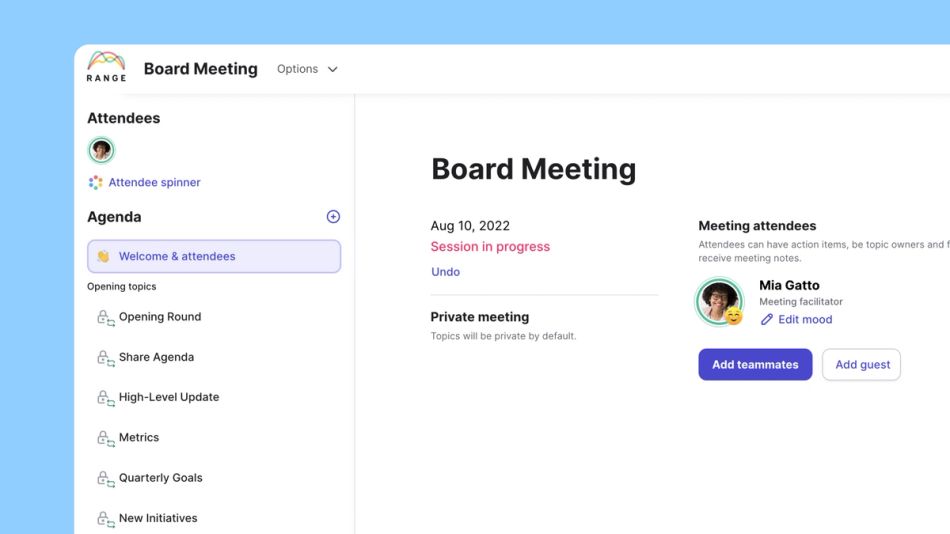
Board meetings are a critical strategic element in charting a course for nearly every business and organization, so by definition, they aren’t all that uncommon.
But a well-run board meeting — one that runs smoothly and efficiently and covers everything the organization needs to chart another quarter or year of successful growth — that kind of board meeting is much less common.
Running a board meeting well isn’t an easy task, and there isn’t exactly a playbook for how to succeed in this role.
In this article, we’ll provide you with 9 best practices that can improve the flow of your next board meeting, not to mention the results.
1. Create an agenda and give the board of directors a heads up
A clear written agenda is the key to any successful board meeting, so you’ll definitely want to invest in creating one. And be sure to create the agenda with plenty of time before the meeting is scheduled to occur.
Board members don’t like being blindsided in meetings any more than the rest of us.
- Send the agenda ahead of time so that all in attendance can plan and orient themselves.
- Consider explaining on the agenda why each item is there. Does the board need to make a firm decision by the end of the meeting, or is a particular point only intended to inform? Knowing the “why” behind each item will help board members better focus their preparation.
- Use an agenda creation tool or template can improve this effort.
- With Range, all directors and board members can see the agenda beforehand. This lets people change or add to the agenda in real time if needed, and meeting notes are sent automatically at the end of the meeting.
2. Spend time familiarizing yourself with the board members & learn their communication styles
Next, it pays to know the people on the board: how they think and communicate, what they enjoy, etc. The board meeting shouldn’t be the only time that leaders like the chair or CEO interact with the rest of the board.
If it is, you may encounter entirely avoidable conflicts or difficulties with open communication.
3. Follow the board meeting agenda as closely as possible
Next up, stick to that board meeting agenda as much as you can. Of course, the unexpected is always possible, but once you’ve sufficiently discussed that unplanned point, get back on track.
Assuming you created a high-quality agenda and distributed it ahead of time, you should expect some (if not all) to come prepared.
Put yourself in their shoes for a moment. They spent precious time preparing for the topics listed in the agenda, only to have the meeting veer off in an unfamiliar or unexpected direction. That’s a frustrating experience!
Data backs this up, too. One recent survey finds that, across all meeting types, off-topic conversations and one person dominating were the top two challenges.
4. Always create a board book
The liaison or facilitator of the board meeting should always create a board book — a collection of documents such as reports and graphs that will guide board members through the agenda.
Think of the agenda as the table of contents, in a way. Each board book section should provide support materials for a corresponding agenda item.
You’ll want to deliver board books a few days before the board meeting (between when you distribute the agenda and the meeting date itself).
One more thing: Board “books” may or may not be physical books or binders these days. A cloud-based board book is a reasonable option.
Board books usually include analysis in the form of:
- Spreadsheets
- PDFs
- Documents
- Images
- Links
If your board meets virtually (an approach with a surprising number of upsides), you may be expected to create a virtual board book.
“Being able to do these meetings without the travel that goes with the traditional board meeting probably gave me more time in some ways to prepare and be focused,” said Dr. Helene Gayle, a member of the boards of Coca-Cola and Colgate Palmolive, to the Harvard Business Review.
5. Avoid adding in any surprising material that’s not included in the agenda
We’ve already recommended that you stick to the agenda, but we know the reality of a free-flowing discussion. If discussing topics on the agenda leads to new, relevant topics, so be it.
But as the board chair or CEO, don’t be the one to throw in a surprise “topic bomb.”
- Executives and directors don’t like being surprised.
- When they are, they tend to be more resistant.
- You also won’t get people’s best ideas on surprise topics they didn’t plan to discuss, and you eat up valuable time, putting the meeting behind schedule.
6. Discuss old business material or items that were previously unresolved
Rehashing discussions from the previous board meeting may seem like a waste of time, and we don’t recommend doing so with every point (beyond potentially reviewing the minutes).
But sometimes, you’ll have carryover material from a previous high-level meeting.
- Perhaps you ran out of time and didn’t get to an agenda point or two, or maybe the spirited discussion didn’t lead to a decision or resolution.
- Sometimes the resolution at the last meeting was that more research was needed. Now is the time to present that research and push for a formal decision.
In other words, if there was anything left hanging after your previous meeting, put it (back) on the agenda and discuss it this time.
7. Discuss new business material or organizational needs
Board meetings should move an organization forward, so numerous agenda items typically relate to new business.
Give this phase plenty of time and ensure that all new business material makes it onto the agenda.
Each new business item should lead to a decision, an action item, or a choice to follow up at the next meeting.
8. Create actionable next steps and present them during the meeting
Board meetings produce quite a bit of conversation, but conversation alone doesn’t move an organization forward.
- Before the executive director and board members leave the boardroom (or virtual equivalent), make sure to push for action.
- These next steps should be presented during the board of directors meeting and delivered in tangible form as board meeting minutes.
- If possible, deliver the minutes and action items during the meeting — not after.
Here’s another place where a meeting tool like Range makes a big difference in your capabilities.

Multiple people can work simultaneously on building this content if desired, and it can be sent electronically to board members or shown on screen while the stakeholders and chairperson are still in the room.
9. Adjourn the meeting
The last step in effectively running board meetings is a clear adjournment within a reasonable time frame.
Allow enough time for robust discussion and be sure to follow parliamentary procedure (e.g., Robert’s Rules of Order) — but keep the meeting to a reasonable length.
If at all possible, adjourn the meeting at the expected time. Not every discussion is valuable enough to justify monopolizing the time of the busy, high-level leaders that comprise your business or nonprofit board.
Key items that you should discuss during a board meeting
Board meetings that deliver the most consistent results focus on the most important items. There will always be dozens of potential topics, concerns, or initiatives, but the most important conversations tend to involve three essential items.
1. Organizational performance
How has the organization performed over the previous fiscal year?
Any significant changes to the status quo — whether positive or negative — should be surfaced for discussion.
- The board needs to know about the big wins: products released, sales targets exceeded, and other significant achievements.
- But it also needs to know where the organization needs to improve.
- If you provided those reports to board members ahead of time, expect that they have read them. Summarize the most important conclusions in the report, but don’t read it verbatim.
While discussing organizational performance is crucial, avoid falling into the trap of simply reading reports or graphs out loud.
2. Future and previous strategies
Your discussion of organizational performance should naturally lead to a discussion on strategies.
- What strategies has the business employed to reach the current level of performance?
- What strategies continue to work well?
- What new strategies should the organization implement to course-correct or ensure continued success?
- In areas where the company fell short, perhaps the previous strategy needs to be reworked.
Look toward the future as well, for both underperforming and successful aspects of the business.
Make sure that the conclusions reached here don’t remain theoretical or intangible. Where possible, create at least a high-level plan for how the business will execute new strategies.
Often you’ll need to leave the detailed work to directors or other leaders. In those cases, simply note who those leaders are and who will communicate the new strategy and vision to them.
3. KPIs and metrics
Key performance indicators (KPIs) and metrics are the tools used to measure organizational performance and, to a degree, the success of current strategies. So any concrete discussion of performance and strategy must bring in the relevant KPIs and metrics.
Discuss existing KPIs in relation to performance and strategy. Then explore whether any new strategies you’ve identified require your organization to begin tracking additional KPIs or metrics.
Sample board meeting agenda (Free template)
You should always customize your board meeting agenda to meet your business's current needs.
Here’s what you’ll cover if you use our sample agenda template without modification.
⭐️ Use the free board meeting template in Range & invite your members.

- Opening round: An icebreaker segment. Discuss how everyone is doing, introduce new members of the team, etc.
- Share the agenda: While you’ve already shared the agenda in advance, take a few minutes to preview the topics planned for the meeting and ensure alignment around those topics.
- High-level update: Share a high-level view of the organizational performance discussion points here, including the wins and the losses.
- Metrics: Cover the KPIs and metrics that reveal organizational performance.
- Quarterly goals: Review specific goals or OKRs tied to the quarter or year, discussing progress and any obstacles to success.
- New initiatives: Future strategies, new product or service offerings, and any other new business initiatives are discussed here.
- Build agenda: As you look to the next board meeting, take a few minutes at the end of this one to solicit board member ideas for the next meeting’s agenda.
- Closing round: Discuss next steps, assign action items, and ensure all agenda items have been processed, completed, or updated.
This sample agenda is a place to start, but again, we know your specific needs may vary.
Host better board meetings with Range
Hosting and running a board meeting that runs smoothly and meets all its objectives is a tall order.
The kinds of leaders that usually end up on boards can be hard to control, and you’ll always have more that you could cover than you have time to cover it.
Any tool that can help keep a board meeting on track and on time — while ensuring that you cover everything you need — is a worthwhile investment.
Range is a powerful meeting platform with an agenda builder for live meetings.
By building your agenda early and distributing it to all attendees, your board members will arrive better prepared. Range also enables you to send out meeting minutes automatically, and you can assign action items to attendees.
Best of all, we’ve already done the legwork for you by creating a board meeting agenda template for use with Range.
Open the template, make the necessary modifications, and start building your next board meeting agenda!
Build your ideal board meeting agenda using Range’s powerful yet flexible free board meeting agenda template.
Board Meeting FAQs
Why are board meetings important?
Whether you’re a nonprofit organization, a small startup, or a publicly traded enterprise, or somewhere in between, holding regular board meetings is crucial: Board meetings provide a regular, scheduled opportunity for directors, board members, and company executives to discuss recent, current, and future business issues, including growth, success, risks, and threats.
Board meetings set the direction for the upcoming term and refine or reshape the organization's strategic direction. They are the topmost leadership meetings, and every other initiative or strategic priority occurring in an organization should flow out of the decisions made and priorities set in board meetings.








